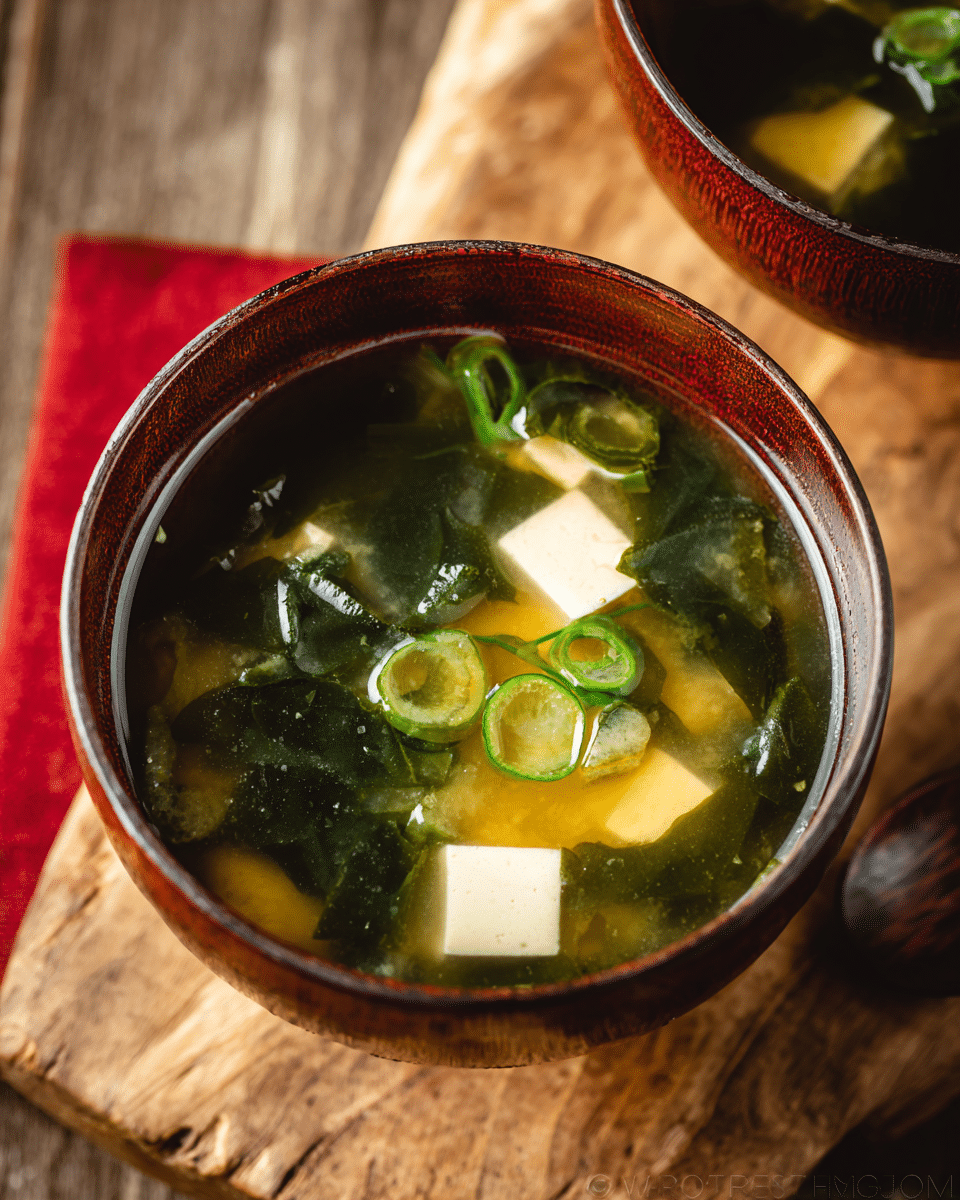The humble miso soup is a beloved staple in Japanese households, traditionally served as part of breakfast, lunch, or dinner. Made from fermented miso paste blended into a savory dashi broth, it’s deeply nourishing, light yet full of flavor, and incredibly easy to prepare.
What makes miso soup so special is the blend of textures and umami silky tofu, slippery wakame seaweed, and the subtle bite of green onions. Whether you’re pairing it with rice and grilled fish or enjoying it as a light meal on its own, this miso soup brings warmth and comfort in every spoonful.
Full Recipe:
Ingredients:
-
4 cups dashi (Japanese soup stock)
-
3 tablespoons miso paste (white or red, to taste)
-
1/2 cup soft tofu, cut into small cubes
-
1 tablespoon dried wakame seaweed
-
2 tablespoons chopped green onions (scallions)
Directions:
-
In a medium saucepan, heat the dashi over medium heat until just before boiling.
-
In a small bowl, mix the miso paste with a ladleful of hot dashi. Stir until the miso is completely dissolved.
-
Lower the heat to maintain a gentle simmer and add the dissolved miso back into the pot.
-
Do not boil the soup after adding miso, as high heat will kill its beneficial probiotics and alter its flavor.
-
Add tofu cubes and rehydrated wakame to the pot. Simmer gently for 1–2 minutes until tofu is heated through and seaweed has expanded.
-
Turn off the heat and sprinkle chopped green onions just before serving.
Prep Time: 5 minutes | Cooking Time: 10 minutes | Total Time: 15 minutes
Kcal: 40 kcal | Servings: 2 servings
The Timeless Warmth of Homemade Miso Soup: A Cultural and Culinary Icon of Japan
In Japanese cuisine, few dishes are as iconic, comforting, and deeply rooted in tradition as miso soup. Known as “misoshiru” in Japanese, this savory broth has graced the tables of homes and restaurants alike for centuries, offering a delicate balance of flavor, nutrition, and simplicity. While it often appears humble, a properly prepared bowl of homemade miso soup is a quiet celebration of umami, the fifth taste, and a reflection of Japan’s reverence for seasonal, balanced meals.
This article explores the cultural significance of miso soup, its health benefits, key components, common variations, and how it has evolved beyond Japanese kitchens to become a beloved dish around the world.
The Cultural Significance of Miso Soup
Miso soup is more than just a starter or side dish in Japanese cuisine it’s a symbol of home. In many traditional households, miso soup is served with breakfast alongside rice, grilled fish, and pickles, forming a wholesome and balanced meal. It’s also a staple in lunchboxes, school cafeterias, and multi-course kaiseki dining.
Historically, miso soup dates back to the 7th century, when Buddhist monks brought the knowledge of fermented soybean pastes from China. Over time, Japan developed its own distinctive types of miso, each tied to local regions and climates. Miso became essential in preserving nutrition during harsh winters, and the soup itself evolved into a versatile dish that could incorporate a wide variety of local ingredients.
Miso soup has spiritual connotations too. In some temples and Shinto rituals, it is offered as food for the gods or used during ancestral ceremonies. In modern times, many Japanese people still associate the scent of miso soup with comfort, homecoming, and the loving care of a family meal.
Miso: A Fermented Flavor Powerhouse
The soul of miso soup is, of course, miso paste a fermented seasoning made from soybeans, salt, and koji (a fermentation starter usually cultivated on rice, barley, or soybeans). The fermentation process can last from a few weeks to over a year, depending on the type of miso being made.
There are several primary types of miso:
-
White Miso (Shiro Miso): Mild, slightly sweet, and lightly fermented. Ideal for delicate soups and beginners.
-
Red Miso (Aka Miso): Richer, saltier, and more robust in flavor due to longer fermentation.
-
Mixed Miso (Awase Miso): A blend of red and white miso, offering a balanced flavor profile.
Each type of miso brings its own character to the soup, and many Japanese households have a preferred miso blend that reflects regional traditions or family taste.
Miso is rich in nutrients, containing protein, essential amino acids, and probiotics that support gut health. The fermentation process enhances bioavailability and creates complex umami flavors that are the hallmark of traditional Japanese cuisine.
Dashi: The Silent Hero Behind the Flavor
While miso paste provides body and flavor, it’s the dashi broth that forms the foundation of miso soup. Dashi is a simple stock, traditionally made from kombu (kelp) and katsuobushi (dried bonito flakes). The ingredients are simmered gently to extract a light yet deeply savory liquid.
There are several types of dashi, including:
-
Kombu Dashi: Vegetarian-friendly and rich in natural umami.
-
Katsuobushi Dashi: Infused with smoky, fishy depth.
-
Niboshi Dashi: Made from dried baby sardines, often used in rural areas.
-
Shiitake Dashi: Made from dried shiitake mushrooms, offering earthy notes.
Dashi’s simplicity allows it to complement miso paste beautifully, highlighting the fermented richness without overwhelming it. For vegetarians or those seeking plant-based options, kombu and shiitake dashi make excellent alternatives to the traditional fish-based broth.
Tofu, Wakame, and Scallions: Classic Additions
A typical bowl of miso soup contains a handful of simple ingredients: soft tofu cubes, rehydrated wakame seaweed, and sliced green onions (negi). Each component adds texture and nutrition.
-
Tofu provides plant-based protein and a gentle creaminess that contrasts with the broth.
-
Wakame adds a subtle brininess and soft, silky texture. It’s also a source of iodine and minerals.
-
Green onions lend freshness and a mild bite to the soup, finishing each spoonful with brightness.
These ingredients are not just selected for flavor but also for balance, in keeping with washoku, the traditional Japanese philosophy of harmonious meals that include color, texture, and seasonality.
Health Benefits of Miso Soup
Miso soup is a nutritional powerhouse in a small bowl. Thanks to its fermented ingredients and mineral-rich components, it offers several health benefits:
-
Probiotics and Gut Health: Fermented miso supports digestion by introducing beneficial bacteria.
-
Low in Calories: A light soup that can be enjoyed daily without overloading on fat or sugar.
-
High in Antioxidants: Ingredients like seaweed and miso contain compounds that reduce inflammation.
-
Rich in Iodine and Minerals: Wakame seaweed supports thyroid function and contains essential nutrients.
-
Heart-Healthy: Low in saturated fat and full of plant-based proteins and micronutrients.
While miso soup can be high in sodium, this can be balanced by using less concentrated miso or low-sodium dashi stock.
Variations Across Japan
Japan’s diverse regions offer unique takes on miso soup. In northern areas like Hokkaido, salmon or potatoes might be added. In Kyoto, white miso dominates, often used with root vegetables and yuba (tofu skin). In Okinawa, pork and awamori (a local spirit) might influence the broth.
Other popular add-ins include:
-
Nameko mushrooms
-
Daikon radish
-
Clams or mussels
-
Eggplant or sweet potato
Each variation reflects the local produce, seasonal availability, and personal or family preferences.
Tips for Making Perfect Miso Soup
To make a great bowl of miso soup at home, here are some tips to consider:
-
Never boil miso: High heat destroys the beneficial probiotics and can cause the paste to lose its delicate flavor. Add it at the end, dissolved in a bit of warm broth.
-
Use quality miso: Look for additive-free miso that’s been naturally fermented. The depth of flavor is worth the investment.
-
Customize for the season: Swap in ingredients like mushrooms in fall or leafy greens in spring.
-
Mind your dashi: Even instant dashi granules can work, but homemade dashi delivers unmatched complexity.
Serving Suggestions
Miso soup is incredibly versatile. It can be served:
-
As a starter in a Japanese-style meal
-
Alongside a bowl of steamed rice and grilled fish
-
With soba noodles for a heartier meal
-
In a thermos as a warming lunch option
-
As part of a macrobiotic or plant-based menu
For a twist, serve it with a drizzle of sesame oil, a sprinkle of shichimi togarashi (seven-spice chili blend), or crumbled nori sheets on top.
A Global Favorite with Enduring Appeal
What began as a humble, everyday dish in Japanese kitchens has now become a global comfort food. Miso soup’s simplicity and health appeal have won it a place in homes and restaurants far beyond Japan. It’s vegan-friendly, quick to make, endlessly adaptable, and deeply satisfying.
Whether you’re enjoying it as part of a traditional Japanese meal or sipping it from a mug on a chilly afternoon, homemade miso soup brings warmth, nourishment, and cultural richness in every bowl. It’s not just a soup it’s a ritual, a memory, and a celebration of flavor and balance.
Conclusion:
Homemade miso soup is a shining example of how simple ingredients, when treated with care and tradition, can yield extraordinary results. It invites us to slow down, appreciate the beauty in subtlety, and connect with a culture that values balance, nourishment, and intention.
Whether you’re discovering it for the first time or it’s a cherished favorite, miso soup is one of those dishes that stays with you a reminder that the most comforting meals are often the ones made with the fewest, but most meaningful, ingredients.






